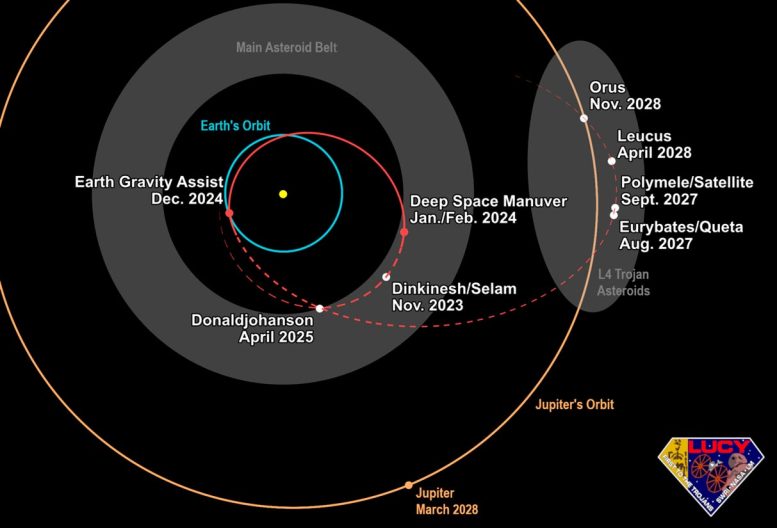NASA’s Lucy mission is the first spacecraft launched to explore the Trojan asteroids, a population of primitive asteroids orbiting in tandem with Jupiter. Credit: NASA’s Goddard Space Flight Center
The Lucy mission aims to study the Jupiter Trojan asteroids through a series of deep space maneuvers and an Earth gravity assist, setting the stage for encounters with asteroid Donaldjohanson and the Trojan asteroid Eurybates.
After its successful first asteroid encounter in 2023, NASA’s Lucy mission has its sights firmly set on its main targets, the never-before-explored Jupiter Trojan asteroids. In 2024, the Lucy spacecraft will transition from its current orbit around the Sun – one that just skims the inner edge of the main asteroid belt – to a new orbit that will carry it beyond the orbit of Jupiter and into the realm of the Trojan asteroids. This will be done in two steps: a series of deep space maneuvers and an Earth gravity assist.
In late January, Lucy will begin the series of two deep space maneuvers. On January 31, the spacecraft will briefly operate its main engines for the first time in space. After analyzing the spacecraft’s performance during that brief burn, the team will command the spacecraft to carry out a larger maneuver, nominally on February 3. Combined, these two maneuvers are designed to change the velocity of the spacecraft by around 2,000 mph (approximately 900 meters per second) and will consume roughly half of the spacecraft’s onboard fuel. Each of the prior spacecraft maneuvers changed the spacecraft’s velocity by less than 10 mph (only a few meters per second) and were small enough to be carried out by the spacecraft’s less powerful thrusters.

The trajectory for NASA’s Lucy spacecraft as seen from a perspective looking down on the solar system. The Sun (yellow circle), orbits of Earth (blue) and Jupiter (orange), as well as the position of Jupiter mid-way through Lucy’s tour (orange circle) and approximate locations of the small body populations (gray) are included for reference. The trajectory of the spacecraft during 2024 is shown as a solid red line (with the prior and upcoming path indicated by dashed red lines). The locations of the spacecraft and the targets at the times of various mission milestones are marked. Credit: NASA/Goddard/SwRI
These maneuvers will place Lucy on course for its second milestone of the year, the spacecraft’s second Earth gravity assist. In December 2024, Lucy will fly within 230 miles (370 kilometers) of the Earth. This encounter will slingshot the spacecraft through the main asteroid belt, where it will encounter asteroid Donaldjohanson in April 2025, and out into the leading (also called the L4 or “Greek”) Jupiter Trojan asteroid swarm. There, Lucy will get its first close-up look at a Trojan asteroid in August 2027, when it reaches Eurybates and its satellite Queta.
NASA’s Lucy Mission
NASA’s Lucy mission, launched in October 2021, is an ambitious space exploration project aimed at studying the Jupiter Trojan asteroids. These asteroids orbit the Sun in two groups, one leading ahead of Jupiter and the other trailing behind, and are thought to be remnants of the early solar system.
Lucy’s goal is to fly by and closely examine several of these Trojans to gain insights into the solar system’s formation and evolution. Over its 12-year journey, Lucy will explore a record number of asteroids, including a main belt asteroid and seven Trojans, making it the first mission to visit these distant and primitive objects. Through its comprehensive suite of scientific instruments, Lucy will measure the asteroids’ compositions, densities, and structures, shedding light on the history of our planetary neighborhood.





